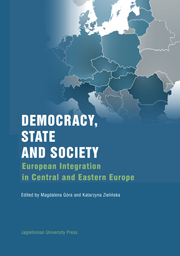Book contents
- Frontmatter
- Contents
- List of contributors
- Europeanisation in the EU New Member States. Aspects and Research Agendas
- Part one Democracy after Enlargement
- Part two Identity Transformations
- Part three Civil Society Organisations in Central and Eastern Europe
- Part four Europeanisation of International Relations
- Index
Europeanisation in the EU New Member States. Aspects and Research Agendas
Published online by Cambridge University Press: 05 September 2014
- Frontmatter
- Contents
- List of contributors
- Europeanisation in the EU New Member States. Aspects and Research Agendas
- Part one Democracy after Enlargement
- Part two Identity Transformations
- Part three Civil Society Organisations in Central and Eastern Europe
- Part four Europeanisation of International Relations
- Index
Summary
After the beginning of the 1989 breakthrough the concept of Central and Eastern Europe (CEE) became widely used as synonym for the group of ten countries from the former Eastern Bloc aspiring to EU membership. A troubled historical experience of long foreign domination, fragile statehood and experience of socialist regimes are shared by Central and Eastern European countries giving this region its distinctive tone. The similarities cannot, however, conceal the differences, as over history the common transformations were moulded by the local particularities – distinct histories, different cultures and dissimilar mentalities of each country.
The recent accession of Central and Eastern European countries to the EU was yet another common experience of the region, initiating chain of alterations at various dimensions of political, legal, social and cultural lives of the new member states. The volume before you is an attempt to present and assess changes resulting from the accession and European integration processes, grasping both similarities and differences in the countries of the region. In this respect the articles collected in the book fit the wider research agenda called Europeanisation.
Europeanisation has become a very fashionable term in social sciences over the last decade. Nonetheless, the concept continues to be challenged and contested (Olsen 2002; Flockhart 2010).
- Type
- Chapter
- Information
- Democracy, State and SocietyEuropean Integration in Central and Eastern Europe, pp. 13 - 26Publisher: Jagiellonian University PressPrint publication year: 2011



